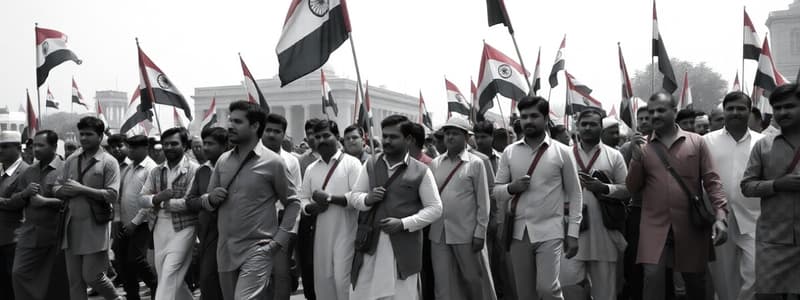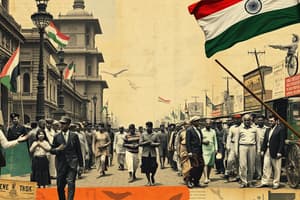Podcast
Questions and Answers
Which of these provinces were separated from India to form Pakistan?
Which of these provinces were separated from India to form Pakistan?
- Assam, Odisha, Bihar, Madhya Pradesh and Rajasthan
- Gujarat, Maharashtra, Kerala, Karnataka and Tamil Nadu
- North-West Frontier Province, Sind, Balochistan, West Punjab and East Bengal (correct)
- Punjab, Haryana, Himachal Pradesh, Jammu and Kashmir
The Indian Independence Act, 1947, marked the end of British rule in India.
The Indian Independence Act, 1947, marked the end of British rule in India.
True (A)
What was the significance of 26 January 1930 for the Indian independence movement?
What was the significance of 26 January 1930 for the Indian independence movement?
The Indian National Congress declared 'Purna Swaraj' or 'Complete independence' as its goal and declared 26th January 1930 as Independence Day.
The Indian dominion was transformed into a ______ on 26 January 1950.
The Indian dominion was transformed into a ______ on 26 January 1950.
Match the following historical events with their corresponding dates:
Match the following historical events with their corresponding dates:
What was the main reason the Congress passed the Quit India Resolution?
What was the main reason the Congress passed the Quit India Resolution?
The Quit India Movement was a well-organized and centrally coordinated effort.
The Quit India Movement was a well-organized and centrally coordinated effort.
How did the British government respond to the Quit India Movement?
How did the British government respond to the Quit India Movement?
The Quit India Movement saw acts of resistance such as demonstrations, _____, and processions.
The Quit India Movement saw acts of resistance such as demonstrations, _____, and processions.
What was one of the key objectives of the Forward Bloc?
What was one of the key objectives of the Forward Bloc?
The Forward Bloc primarily focused on achieving economic equality and justice within India.
The Forward Bloc primarily focused on achieving economic equality and justice within India.
Match the following events to their respective dates:
Match the following events to their respective dates:
What significant event led to the partition of India and the creation of Pakistan?
What significant event led to the partition of India and the creation of Pakistan?
Which of the following was a consequence of the Quit India Movement?
Which of the following was a consequence of the Quit India Movement?
The Quit India Movement was entirely peaceful.
The Quit India Movement was entirely peaceful.
The ______ Plan proposed the division of British India into India and Pakistan.
The ______ Plan proposed the division of British India into India and Pakistan.
Match the following individuals to their respective roles:
Match the following individuals to their respective roles:
What was one of the key reasons the Congress felt the British should leave India?
What was one of the key reasons the Congress felt the British should leave India?
Which of these actions did Subhash Chandra Bose NOT take in his pursuit of Indian independence?
Which of these actions did Subhash Chandra Bose NOT take in his pursuit of Indian independence?
Why is Subhash Chandra Bose still revered in India?
Why is Subhash Chandra Bose still revered in India?
Netaji Subhash Chandra Bose was only admired by people who lived during the Indian independence movement.
Netaji Subhash Chandra Bose was only admired by people who lived during the Indian independence movement.
Flashcards
Objectives of the Forward Bloc
Objectives of the Forward Bloc
To achieve swift freedom from British rule, promote socialism, and ensure world peace.
Subhash Chandra Bose's Approach
Subhash Chandra Bose's Approach
Believed armed struggle was necessary for India's freedom; resigned from Congress to pursue this path.
Formation of the Forward Bloc
Formation of the Forward Bloc
Created by Subhash Chandra Bose in 1939 after leaving Congress to strengthen the fight for independence.
Bose's Escape
Bose's Escape
Signup and view all the flashcards
Leadership in INA
Leadership in INA
Signup and view all the flashcards
Bose's Legacy
Bose's Legacy
Signup and view all the flashcards
Mountbatten Plan Importance
Mountbatten Plan Importance
Signup and view all the flashcards
Communal Riots Effect
Communal Riots Effect
Signup and view all the flashcards
Quit India Resolution
Quit India Resolution
Signup and view all the flashcards
Gandhiji's Arrest
Gandhiji's Arrest
Signup and view all the flashcards
Nationwide Protests
Nationwide Protests
Signup and view all the flashcards
Government Response
Government Response
Signup and view all the flashcards
Violent Reactions
Violent Reactions
Signup and view all the flashcards
Death Knell of British Rule
Death Knell of British Rule
Signup and view all the flashcards
Impact on National Sentiment
Impact on National Sentiment
Signup and view all the flashcards
Role of the Army
Role of the Army
Signup and view all the flashcards
Indian Independence Act, 1947
Indian Independence Act, 1947
Signup and view all the flashcards
Mountbatten Plan
Mountbatten Plan
Signup and view all the flashcards
26 January 1950
26 January 1950
Signup and view all the flashcards
Poorna Swaraj
Poorna Swaraj
Signup and view all the flashcards
Sovereign Democratic Republic
Sovereign Democratic Republic
Signup and view all the flashcards
Study Notes
Indian National Movement - Quit India
-
Quit India Resolution: Passed by Congress due to the risk of a Japanese attack on India if the British remained. The British presence made India a potential target.
-
Government Reaction: The movement challenged British rule. Nationalist leaders, including Gandhiji, were arrested on August 9, 1942. Congress was banned, and protestors faced harsh crackdowns (e.g., lathi charges, firing on protestors).
-
Outcome of the Quit India Movement: The movement was brutally suppressed within a short period. Thousands were killed, and the goal of achieving immediate freedom by violent means failed.
Indian National Movement - Objectives of the Forward Bloc
-
Winning Freedom: The Forward Bloc aimed to end British rule immediately.
-
Rebuilding India: The Forward Bloc envisioned a socialist India with economic equality, freedom, justice, and equitable wealth distribution.
-
Global Peace: The Forward Bloc aimed to promote world peace.
Indian National Movement - Subhas Chandra Bose
-
Belief in Armed Force: Bose believed armed force was the only way to remove the British from India.
-
Forward Bloc Creation: He formed the Forward Bloc in 1939, after resigning from the Congress Party.
-
Escape and Leadership in INA: Bose escaped house arrest, traveled abroad (Russia, Germany, and Japan), and took leadership of the Indian National Army (INA). He became the Supreme Commander of the INA and vowed to free India.
Indian National Movement - Significance of 26th January 1950
-
Adoption of Constitution: India's constitution became operational on January 26, 1950, marking its transformation to a sovereign democratic republic.
-
Declaration of Independence: This date commemorates the day that India pursued Independence from British colonial rule and it established a new country founded on values of liberty, equality, justice and fraternity.
Indian National Movement - Mountbatten Plan
-
Transfer of Power: Lord Mountbatten, the new viceroy, created a plan for transferring power from the British to India and Pakistan;
-
Partition: The plan factored in the inevitability of the partition of British India into two separate countries: India and Pakistan. This divided the North-West Frontier Province, Sind, Balochistan, West Punjab, and East Bengal from the rest of India.
-
Indian Independence Act: The Indian Independence Act of 1947 implemented Lord Mountbatten's plan. The British parliament enacted this legal framework formalizing India and Pakistan as independent nations.
Indian National Movement - Impact of Quit India
-
Outburst of National Sentiment: A brief but powerful expression of nationalist fervor emerged.
-
Death Knell for British Rule: The movement was a significant indication that British dominance was coming to an end.
-
Capacity for Suffering: The movement demonstrated India's dedication to winning her Independence.
Studying That Suits You
Use AI to generate personalized quizzes and flashcards to suit your learning preferences.




